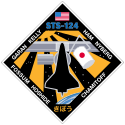Gregory Chamitoff
| Gregory Chamitoff | |
|---|---|
 | |
| NASA Astronaut | |
| Statsborger | USA |
| Nationalitet | Amerikansk |
| Født | 6. august 1962 Montreal, Canada |
Andet arbejde | Ingeniør |
| Uddannelses- sted | California Polytechnic State University California Institute of Technology Massachusetts Institute of Technology University of Houston–Clear Lake |
| Rang | Ph.d. |
| Udvælgelse | NASA-gruppen fra 1998 |
| Mission(er) | NEEMO, STS-124, STS-126 |
| Missionsemblemer | |
Gregory Errol Chamitoff (født 6. august 1962) er en NASA-astronaut og har fløjet to rumfærge-mission og været fast besætning på Den Internationale Rumstation. Han har opholdt sig ni dage i et undervandslaboratorium NEEMO i 2002, der minder om forholdene om bord på en rumstation.[1]
Udover en Ph.D. grad i aeronautic & astronautic fra MIT har Gregory Chamitoff også uddannelser i Planetary Geology (rumvidenskab), Aeronautical Engineering og Electrical Engineering.
Chamitoff ankom med STS-124 Discovery 2. juni 2008 og afløste Garrett Reisman på den 17. ekspedition til Den Internationale Rumstation. Han blev selv afløst af Sandra Magnus i november 2008 og rejste hjem med STS-126 Endeavour.
Eksterne henvisninger
- NASA Biografi af Gregory Chamitoff (engelsk)
- interview STS-124 Arkiveret 28. juni 2008 hos Wayback Machine (engelsk)
- ^ "Neemo 3". Arkiveret fra originalen 8. oktober 2006. Hentet 29. maj 2008.
|
Medier brugt på denne side
The STS-126 patch represents Space Shuttle Endeavour on its mission to help complete the assembly of the International Space Station (ISS). The inner patch outline depicts the Multi-Purpose Logistics Module (MPLM) Leonardo. This reusable logistics module will carry the equipment necessary to sustain a crew of six on board the ISS and will include additional crew quarters, exercise equipment, galley, and life support equipment. In addition, a single expedition crew member will launch on STS-126 to remain on board ISS, replacing an expedition crew member who will return home with the shuttle crew. Near the center of the patch, the constellation Orion reflects the goals of the human spaceflight program, returning us to the Moon and on to Mars, the red planet, which are also shown. At the top of the patch is the gold symbol of the astronaut office. The sunburst, just clearing the horizon of the magnificent Earth, powers all these efforts through the solar arrays of the ISS current configuration orbiting high above.
Emblem of Nasa's STS-124 mission.
- The STS-124/1J patch depicts the Space Shuttle Discovery docked with the International Space Station (ISS). STS-124/1J is dedicated to delivering and installing the Japanese Experiment Module (JEM) known as Kibo (Hope) to the ISS. The significance of the mission and the Japanese contribution to the ISS is recognized by the Japanese flag depicted on the JEM Pressurized Module (JPM) and the word Kibo written in Japanese at the bottom of the patch. The view of the sun shining down upon the Earth represents the increased "hope" that the entire world will benefit from the JEM's scientific discoveries. The JPM will be the largest habitable module on the ISS and is equipped with its own airlock and robotic arm for external experiments. In addition to delivering and installing the JPM, the STS-124 crew will relocate the JEM Logistics Pressurized (JLP) module to its permanent home on the zenith side of the JPM. During three planned space walks, the crew will perform external ISS maintenance and JPM outfitting, as well as extensive robotic operations by the ISS, space shuttle, and JEM robotic arms. It will be the first time that three different robotic arms will be operated during a single space flight mission.



